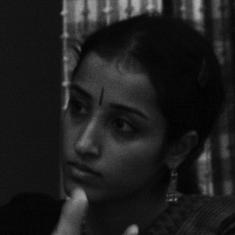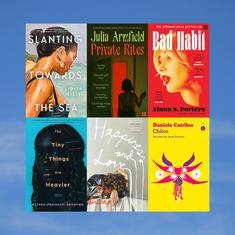She pitched the ball outside the off stump to the left-hander batsman. The batsman swung but missed, the ball smacking the middle stump. History probably won’t remember that batsman. Hamza, for one, doesn’t. She only remembers the sweet thwack of leather on wood and the feeling afterwards – of sheer blank excitement at taking her first wicket.
It was the first wicket of the match between the Western Cape Province team and the Zimbabwean Senior Women’s National team at a stadium in Pineland, in Cape Town’s southern suburbs. Hamza had made history simply by being there. At 10, she was possibly the youngest player ever to play against an international cricket side.
Three overs later, she was involved in the second wicket of the match, when fielding at short fine leg, the batsman hoicked the ball in her direction. “First I thought I might drop it, then I thought of nothing,” she said at a meeting at Central Hockey Club in the Rylands area, a suburb of Cape Town.
The rest of that match last November was washed out, with just those two wickets falling.
Better than boys
Hamza first began playing cricket two years ago when she was nine. Her father Boebie, a theatre person, said she slid right into the sport. Hamza, now in Class V and 11 years old, has accumulated 432 runs and 47 wickets, over the 22 games she has played since September 2013 for different teams. Some of those runs and wickets have come playing in a boys’ team for St Augustine, a local club. Founded in 1899, the club is one of the country’s oldest, and has seen in its line up former international players such as Paul Adams and Basil D’Oliveira.
It’s not easy playing with the boys, according to Boebie, “because she is better than all of them”. This is said with the air of someone stating an incontrovertible fact, but the acclaim support him. In the 2013-2014 season, she won five of the six awards handed out by the club in her division, including best batsman, best bowler and best all-rounder.
On the field, the 10-year-old boys say lots of 10-year-old boy things. When she’s batting, the wicket-keeper might tell the bowler to “Get my girlfriend out”. “That’s their favourite chirp,” said Hamza. “I’m used to it.”
When it’s her turn to bowl and she takes wickets, the chirps flow both ways. “Then my teammates will tell the batsman, ‘you got bowled by a girl’.”
Still, she never sledges or responds to the banter. “She used to get emotional earlier, but now she keeps them quiet by scoring runs,” said Boebie.
Two-sport wunderkind
Hamza’s great grandfather was born in Harkol, a village in Maharashtra’s Ratnagiri district, and came to South Africa in 1923 when he was 16. The rest of her genetic make-up is part-German, part-Dutch. She is what in South Africa is described as coloured – a patchwork of heritage, with brown skin colour ranging from deeply burnished to lightly toasty.
Cricket is still a white-dominated sport in South Africa but the men’s side has seen more black and coloured faces with the advent of affirmative action. The women’s game, like women’s games in most places, languishes in the shadow of the men’s sport, and the game for younger women is even less well developed, especially at the club level. St Augustine, for instance, has no girls’ teams.
When I met Hamza, she was getting ready for hockey practice. That’s the other thing. She also plays hockey – very well. With 420 goals to her name and membership in under-11, under-13, under-14 and under-16 girls’ teams, Hamza is hard-pressed to choose between the two sports.
“I don’t know,” she said, after thinking briefly over which she preferred, and then receded into giggles. Hair plaited, legs swinging on the chair, her pink socks pulled up to the knees, Hamza was bright-eyed and restless.
She practices daily and the sport depends on the season. The sporting goods company Slazenger came across her and signed her up for a two-year contract, marking the first partnership of the company with any female cricketer in the world. “With exceptional talent such as Malikah’s it was a very easy decision to make,” said Evert Ferreira, the company’s brand activation manager.
Confident and tough
Hamza might play for a senior women’s side but she betrays no world-weary wisdom or self-consciousness about playing with women much older than her. She isn’t precocious either. She is happy in her 11-year-old skin, talking about Xboxes and Roald Dahl with child-like exuberance.
When I met them, Boebie started playing videos of some of her performances. Hamza comes careening in with her loopy, tangled-up bowling action. Some have compared her to the South African leg-spinner Paul Adams. “She comes with such confidence, she’s tough and can hold her own,” said Dawn Sheryll Adams, 55, a senior player for the St Augustine women’s team and team manager. “She knows the game, she reads the game in a manner that would put seniors to shame.”
Hamza peered at the video footage and cheerfully berated her screen self for heaving and going for the slog. “Sorry, sorry,” she exclaimed. Boebie is considerate. “Nah, that one I forgive you,” he replied. Boebie is a purist. “She knows I get angry if she doesn’t play proper cricketing shots.”
He is unhappy that his daughter is trapped in a school sports system that doesn’t allow her to play at her level. In the clubs it’s different. There is more freedom. She can play with 10-year-old boys one day and with 25-year-old women the next.
Two years ago, when she was nine and playing against the University of Cape Town team, one of the bowlers tossed gentle deliveries at her, concerned she wouldn’t be able to absorb the pace. She unleashed a couple of fours and finished the match on 28 not out. Now, she relishes the prospect of facing speedsters. “I love it,” she said. “With slower bowling you get impatient.”
When the cricket season resumes in September, she will continue to play for her club in the boys’ under-11 and the ladies’ teams.
“She’s intimidating to the boys,” said Dawn Adams. “But they also know that they will win if she is on the team.”










